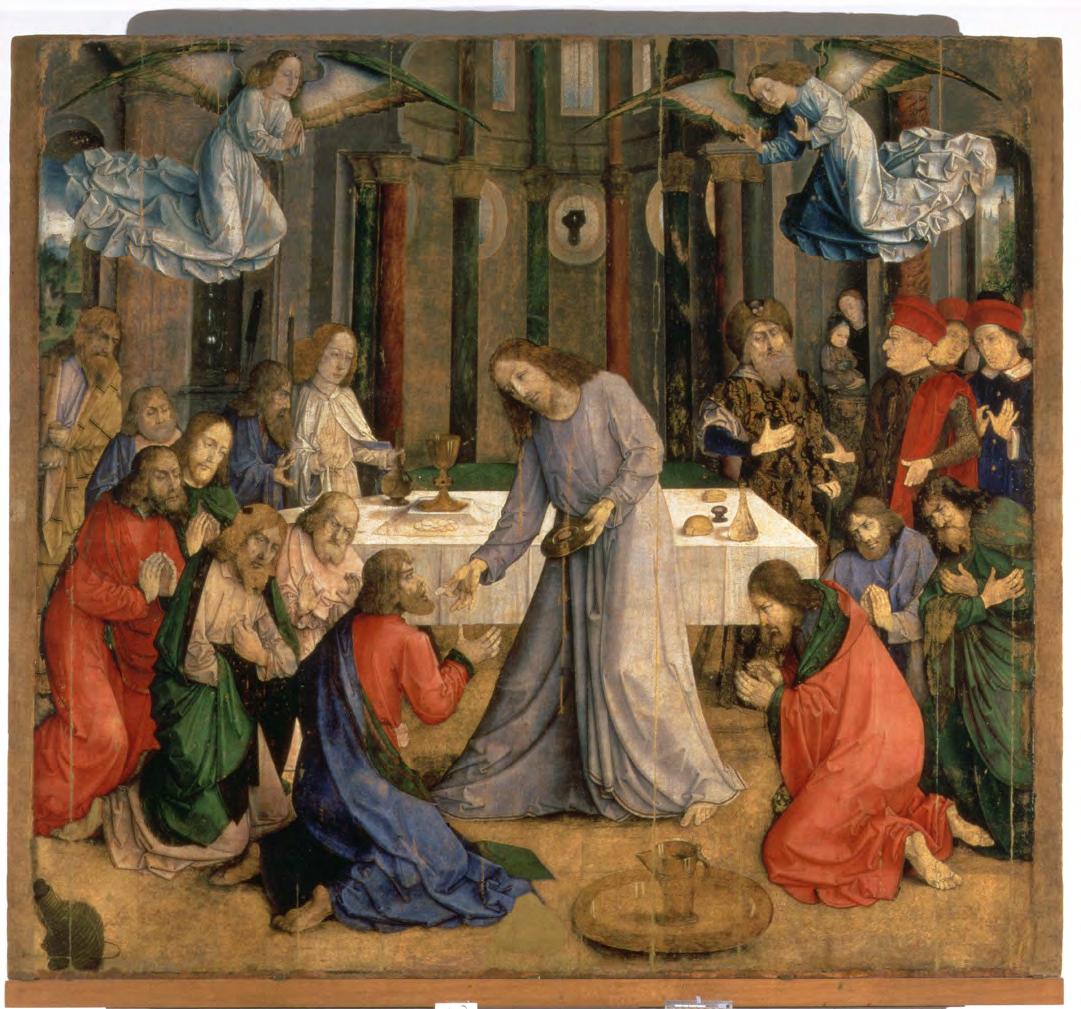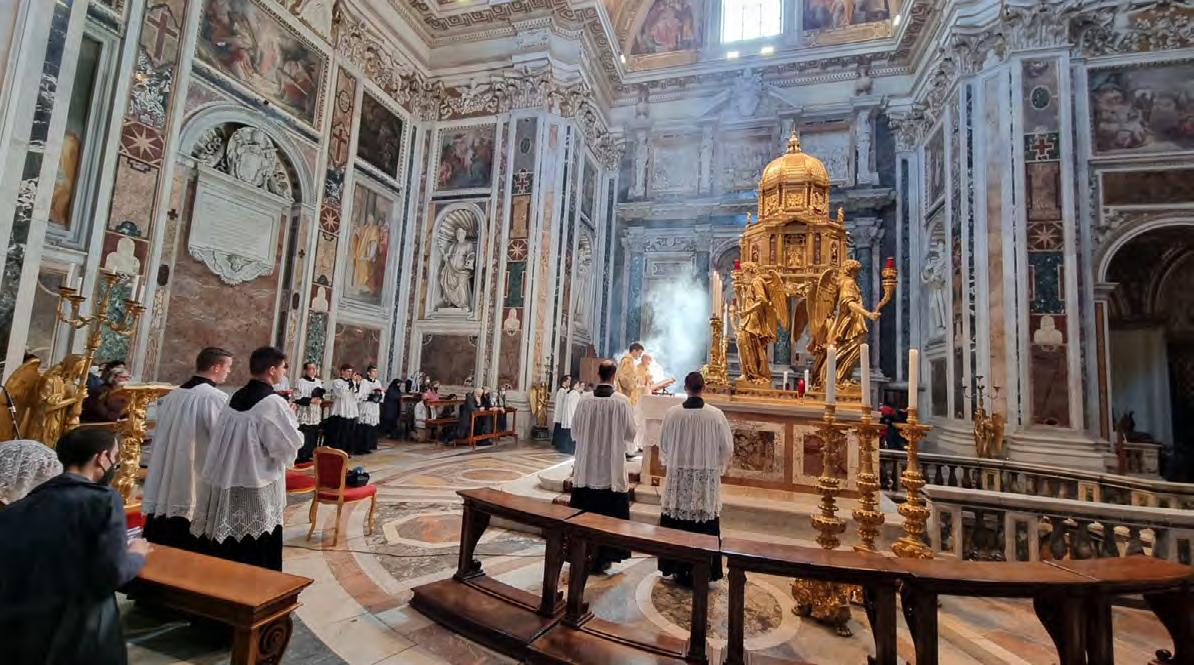
10 minute read
The Bonnie Marchioness of Lothian
Charles A. Coulombe remembers the life and work of Cecil Chetwynd Kerr
We often remember the great converts who came out of the Oxford Movement, starting with Cardinal Newman. While the names that first come to mind of that group are men, “many women were there also”. Of these, perhaps the best known was Cecil Chetwynd Kerr, Marchioness of Lothian (1808-1877). Lady Lothian was a descendant of the Talbot Earls of Shrewsbury. The Talbots descend from a cousin of William the Conqueror. One branch became Earls of Shrewsbury in 1442, from which she descended; after the break with Rome, a number of the Earls were staunch Catholics. Lady Lothian’s father, Charles Chetwynd-Talbot, 2nd Earl Talbot, although a Shrewsbury descendant, was Anglican. When the Catholic 17th Earl of Shrewsbury died childless, Lady Lothian’s oldest brother succeeded to the title as the closest living cousin. The passing of one of “their” peerages to a Protestant was very dispiriting to the nation’s Catholics; little did they know that one of that very family would more than make up for it.
Born and raised at Ingestre Hall, the family seat in Staffordshire, the future Marchioness was the sixth of twelve children; her mother died shortly after the birth of the last child. Her father was extremely attentive to her education. She was extremely well read, and interested in religion – which last interest would be a defining one in her future life.
Distinguished as her family were, and as steeped in Cavalier and Stuart traditions, was that of her husband, noted Tory paladin John Kerr, 7th Marquess of Lothian, whom she married in 1831. They had five sons and two daughters in rapid succession, but after a decade of marriage, Lord Lothian died at the early age of 47.
The year before he died, Lady Lothian had already moved to their estate at Monteviot House, which remains in the family today, in order to be close to the Scottish Episcopal Church in Kelso. This branch of Anglicanism was in those days more “High Church” than its sister church in England, due to its Jacobite and Nonjuring background. After her husband’s death, the Dowager Lady Lothian became closely involved with the Oxford Movement, and its leader, John Henry Newman.
In 1843, Lady Lothian funded (to the tune of £4,000) the building of a new Anglican church - St John’s Jedburgh. Her intention was the creation of a church entirely adapted to Tractarian principles, which would also serve as a symbol of the rebirth of Scottish Episcopalianism. So impressed were Lady Lothian’s neighbours, the Duke and Duchess of Buccleuch, that they endowed St Mary the Virgin, Dalkeith the following year; its first incumbent became Lady Lothian’s confessor.
In 1845, Newman’s crossing the Tiber sent shockwaves through the nascent Anglo-Catholic community. Lady Lothian was deeply affected and began receiving instructions when in London from Henry Edward Manning. She was received into the Church in 1851. Although her two older sons remained Anglican, her younger children followed her into the Faith. Lady Lothian decided to visit Newman at the Birmingham Oratory, and was struck by the “unearthly” atmosphere in which he offered the Mass. But, “He was most kind,” she wrote, “… so full of sympathy and Christian love that he is the last person one would need to be afraid of. That which struck me most was his childlike sympathy and humility, and next to that, the vivid clearness with which he gives an opinion.” The Lothians’ principal seat, Newbattle Abbey, had of course been pilfered from the Church at the Protestant Revolt by an earlier generation of Kerrs. After her conversion, this became a problem for her. As Abbot Sir David Oswald Hunter Blair later recalled, “Lady Lothian had been left a widow with seven children ten years before her conversion, and their usual place of residence was Newbattle Abbey near Edinburgh, a stately mansion built on the site, and out of the very stones, of the famous Cistercian monastery gifted by King David I to the White Monks six centuries before. So uneasy was this pious Catholic lady, during her son's minority, at living in a house haunted by such memories and such traditions, that on the occasion of one of her visits to Rome she unfolded her scruples to the Pope himself. ‘Sta tranquilla, figlia mia,’ was the reply of the kind old Pontiff; but the lady's apprehensions could only be laid to rest by the receipt of a document under Pio Nono's own sign manual, authorising her and her children to occupy their Scottish home in peace. The Papal permit was long treasured at Newbattle, and was preserved in the very same case which contained one of the most venerable archives of the house - the original deed confirming the grant of Newbattle by King David to the Cistercian monks.”
Continuing to aid the poor in Edinburgh, in company with the Duchess of Buccleuch, her influence led the latter to convert in 1860 – as did her brother, Lord Charles Thynne, who had been an Anglican cleric. From the time she converted, the Dowager Marchioness of Lothian never again entered St John’s which she had so generously endowed. She soon became aware of the influx of post-Potato Famine Irish immigrants into the Edinburgh area, so for their spiritual welfare and her own, she endowed another church – this time Catholic – St David’s, Dalkeith in 1853. She wanted it named in honour of St David I, King of Scots, in reparation for the many religious foundations he was responsible for that were destroyed at the Protestant revolt. The following year, she represented the parish in Rome at the ceremonies surrounding the definition of the Immaculate Conception. Her friendship with Bl Pius IX resulted in the High Altar being Privileged – that is, that anyone for whom a Mass is offered upon it receives a Plenary Indulgence. When, in 1860, the Jesuits came to Edinburgh, Lady Lothian (bearing in mind her connections with Farm Street) successfully petitioned that St David’s be given into their charge. The number of Catholics in the area continued to grow, so that, in 1872, Lady Lothian felt constrained to endow another, smaller church – St Mary’s at Pathhead.
The Catholic population continued to grow, as more Irish workers were brought in for various projects, and a few Scots converted. In 1876, the numbers around the villages of Penicuik and Loanhead demanded the building of at least one new Catholic church in the area, and the redoubtable Marchioness bought property in Roslin (between the two) to build a church. But, it being decided that two separate parishes would be better, she sold the land, and put the money into separate buildings. Having paid for the design and building of what would be called St Margaret of Scotland, Loanhead, Lady Lothian set off on another pilgrimage to Rome, in 1877. Unfortunately, or otherwise, Her Ladyship died there, but by a special privilege her body was interred by the altar at St David’s, Dalkeith. Abbot Sir David Oswald Hunter Blair remembered, “I was in Rome during her last illness and death there in 1877, and well remember the extraordinary reputation for sanctity which she enjoyed, far beyond the circle of her own friends and acquaintances. Her death was really due to her selfsacrifice; for she caught a chill which she could not throw off by insisting, though in delicate health, on escorting to all the holy places of Rome -many of them underground—the young convert, Lady Flora Hastings, who was her guest in the Eternal City. The news of her illness spread consternation through Rome: the neighbourhood of the Albergo di Roma, where she was lying, was besieged by sympathising inquirers; and in scores of churches votive candles were lit and prayers offered for her recovery and, when that was seen to be impossible, for her happy death. Her youngest son Lord Ralph, who was on his way home from India, had the consolation of reaching Rome just in time to close his mother's eyes.” But the year following Lady Lothian’s death, Pope Leo XIII restored Scotland’s hierarchy, and her last foundation at Loanhead became the first parish canonically erected in the renewed Archdiocese of Edinburgh and St Andrews.
Lady Lothian’s legacy was rather larger than the parishes she built and monies she spent. Her two oldest sons remained Anglican, as was the latter’s offspring, the 10th Marquess, who died in 1930. Her third son, Lord Ralph Kerr, converted with her. He pursued a distinguished career in the British Army, reaching the rank of Major General, and marrying Lady Anne FitzalanHoward. She was the daughter of Henry Fitzalan-Howard, 14th Duke of Norfolk (the premiere Peer in England, and ranking Catholic layman in the country), and Honourable Augusta Mary Minna Catherine Lyons, the daughter of ViceAdmiral Edmund Lyons, 1st Baron Lyons. Alas, this distinguished Catholic ancestry did not keep their son, Philip Kerr, in the Faith. Although educated at the Brompton Oratory, the future 11th Marquess (he inherited the title from his childless Anglican cousin in 1930) he defected from the Church, joining the Christian Science religion with his close friend, Nancy Astor.
Lady Lothian’s youngest son, Lord Walter Kerr, had also converted with her, and went into the Royal Navy. Joining in 1853, he served in all of his country’s naval conflicts until ending his career in 1904 as First Sea Lord. He then devoted himself to various Catholic interests, serving amongst other things as President of the Catholic Union of Great Britain. In 1873, he had married Lady Amabel Frederica Henrietta Cowper, daughter of George Cowper, 6th Earl Cowper. Lady Amabel had converted to Catholicism herself the year before, and as with her mother-inlaw threw herself into working for the Church – especially, in Lady Amabel’s case, in writing. Part of Lady Amabel’s inheritance which came into the marriage with her was Melbourne Hall, in Derbyshire. The couple moved there in 1906, and the local Catholic bishop, expecting converts in their wake, appointed a chaplain. The parish began functioning in a converted laundry room on the estate, but two years later – with a great deal of help from Lord Walter and Lady Amabel – the church of Our Lady of Mercy and St Philip Neri was solemnly dedicated. Although Melbourne Hall and its estate remains in the family’s hands today, they donated the church and its property to the diocese in 1982. Lord Walter’s and Lady Amabel’s oldest son, Ralph, became a priest; but the next boy, Andrew, entered the Navy, as had his father. He in turn married Marie Constance Kerr, a distant relative; they both died in 1929.
When the 11th Marquess died in 1940, Andrew’s son Peter (1922-2004) succeeded, thus bringing the title back into Catholic hands. Educated at Ampleforth Abbey, he married Antonella Newland. In addition to a distinguished career in Conservative politics, he was active as a Knight of Malta. In 1979, he returned the Abbey of San Damiano, where the miraculous crucifix spoke to St Francis, to the Franciscan order. On his death, his son Michael – long known as Tory politician Michael Ancram – succeeded as 13th Marquess. He married Lady Jane Fitzalan-Howard, the fourth daughter of the 16th Duke of Norfolk; they are both active in Catholic causes, including the Right-to Life Trust.
The story of Lady Lothian and her work for the growth of the Faith in England and Scotland deserves to be better known. Certainly, her gentle but firm influence continues to be felt in various ways across the island, both in the institutions she founded or helped, and in the work of her descendants.

Lady Lothian: her work for the growth of the Faith in England and Scotland deserves to be better known









